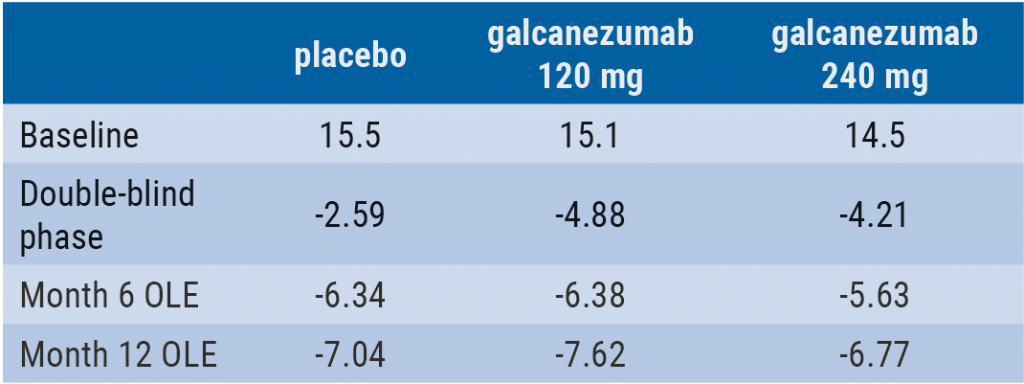Monoclonal antibodies (mAb) targeting calcitonin gene-related peptides (CGRP), such as CGRP-receptor antagonist erenumab and CGRP-ligand blocker galcanezumab, are a novel treatment class for migraine prevention. A previous (f)MRI study showed that erenumab had not only peripheral but additional central effects in patients with migraine. Moreover, anti-CGRP mAbs may modulate peripheral pain processing and differences in sensory thresholds may discriminate clinical responses [3].
Central effects of galcanezumab
Dr Hauke Basedau (University Medical Centre Hamburg-Eppendorf, Germany) hypothesised that galcanezumab would alter trigeminal central pain processing; that responders to galcanezumab would show modulation of specific central areas (specifically in the hypothalamus) in contrast to non-responders; and that the efficacy can be predicted as early as day 1, i.e. before administration.
Dr Basedau and colleagues conducted an fMRI study that included 26 patients with migraine using an established trigeminal nociceptive paradigm with gaseous ammonia. The current study assessed the patients before and 2–3 weeks after the administration of galcanezumab. Results indicated that galcanezumab reduced hypothalamic activation, which was more prominent in responders versus non-responders. “We concluded that there is a central effect associated with the administration of galcanezumab,” said Dr Basedau.
Furthermore, results indicated that the activity of the spinal trigeminal nucleus followed by trigemino-nociceptive stimulation before treatment covaried with the response to galcanezumab. The functional connectivity between the spinal trigeminal nucleus and the hypothalamus was found to decrease after galcanezumab administration. The more the spinal trigeminal nucleus was activated due to painful stimulation before galcanezumab administration, the higher the likelihood of responding to galcanezumab. “Quite interesting is that this is approximately the same hypothalamic area that we have already found as the corpus delicti for an increase in headache base, or at least being an area of interest in migraine-associated headache,” concluded Dr Basedau.
Effect on somatosensory processing
In a second analysis, the 26 patients also underwent quantitative sensory tests before and 2–3 weeks after galcanezumab administration [2]. Dr Kuan-Po Peng (University Medical Centre Hamburg-Eppendorf, Germany) shared the results of this study.
After the administration of galcanezumab, the heat pain threshold and mechanical pain threshold increased significantly (P<0.05), but exclusively in the V1 dermatome and not on the forearm. Changes between the before and after measurements did not differ regarding clinical response. A clinical responder was defined as having a ≥30% reduction in headache frequency after 3 months of treatment.
Baseline heat pain threshold predicted a clinical response and inversely correlated with the baseline headache frequency, suggesting that clinical response may be associated with individual susceptibility and disease activity.
- Basedau H, et al. Galcanezumab has central effects in the migraine brain. AL069, IHC 2021, 8–12 September.
- Peng K-P, et al. Galcanezumab changes somatosensory perception exclusively in the face, whereas heat pain threshold before treatment predicts efficacy. AL062, IHC 2021, 8–12 September.
- Ziegeler C, et al. Neurology. 2020;95(20):e2794–802.
Copyright ©2021 Medicom Medical Publishers
Posted on
Previous Article
« Long-term safety and tolerability of atogepant in migraine Next Article
Galcanezumab effective in patients with episodic or chronic cluster headache »
« Long-term safety and tolerability of atogepant in migraine Next Article
Galcanezumab effective in patients with episodic or chronic cluster headache »
Table of Contents: IHC 2021
Featured articles
Letter from the Editor
COVID-19
Telemedicine beneficial for headache care during the pandemic
Comparison of headaches after SARS-CoV-2 vaccination
Grey matter cortical changes in patients with persistent headache after COVID-19
Increased risk of cerebral venous thrombosis in COVID-19
Patient Perception and Symptoms
Predictors of health-related quality of life in cluster headache
Dry eye disease is more prevalent in migraine
Voice change and throat swelling are cranial autonomic symptoms in primary headache
Association between physical inactivity and headache disorders
Increased suicidal attempts and risks of ideation in medication-overuse headache
Cardioembolic Comorbidities
AI-enabled ECG algorithm predicts atrial fibrillation risk in migraine
Migraine may not be a risk factor for stroke
Imaging
Functional brainstem somatotopy of the trigeminal nerve during nociception
Morphological changes in cluster headache between attacks
Interictal pontine metabolism in migraine patients without aura
Genome-Wide Association Studies
Largest genome-wide association study of migraine to date
Robust evidence that cluster headache has a genetic basis
Pharmacological Treatment
Insights in drug-drug interactions facilitate rational polypharmacy
Rimegepant confers long-term improvements in MMDs
First real-world effectiveness data of erenumab is promising
Galcanezumab effective in patients with episodic or chronic cluster headache
Central effects and affected somatosensory processing with galcanezumab in migraine
Long-term safety and tolerability of atogepant in migraine
Non-Pharmacological Treatment
Occipital nerve stimulation effective and safe in chronic cluster headache
Related Articles
October 27, 2020
Improvement of migraine using CGRP mAbs in a real-world setting

August 27, 2019
Galcanezumab reduces healthcare resource utilisation
October 27, 2020
Worldwide survey shows substantial burden of migraine
© 2024 Medicom Medical Publishers. All rights reserved. Terms and Conditions | Privacy Policy
HEAD OFFICE
Laarderhoogtweg 25
1101 EB Amsterdam
The Netherlands
T: +31 85 4012 560
E: publishers@medicom-publishers.com

